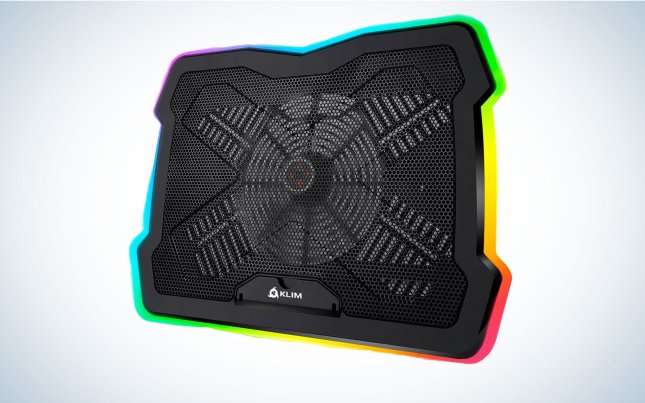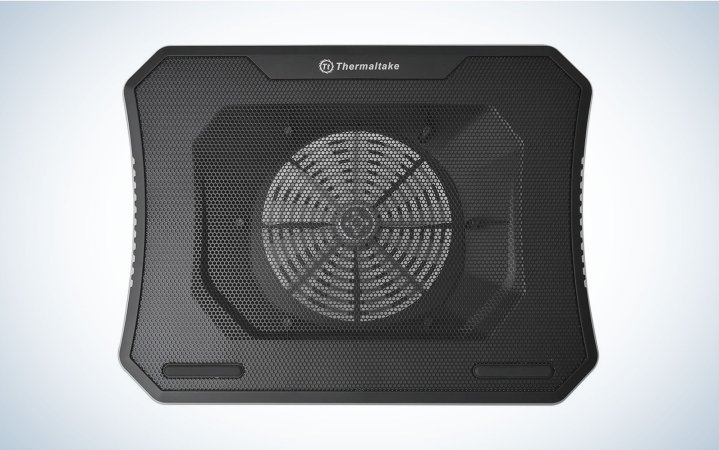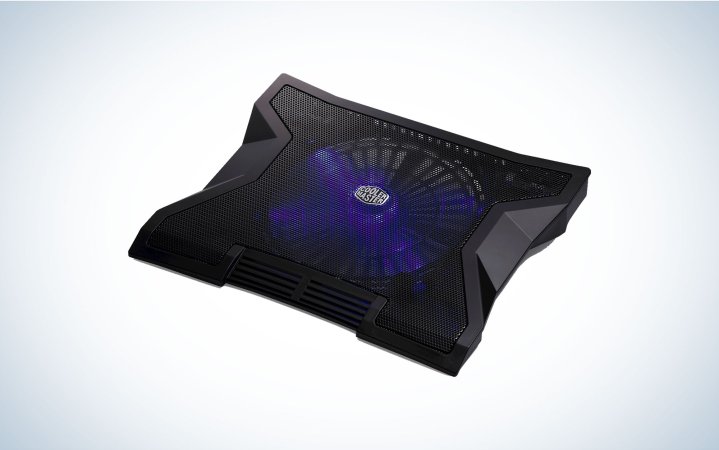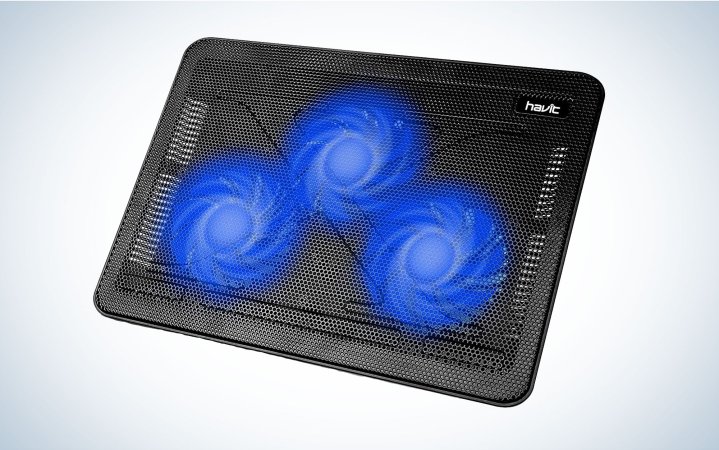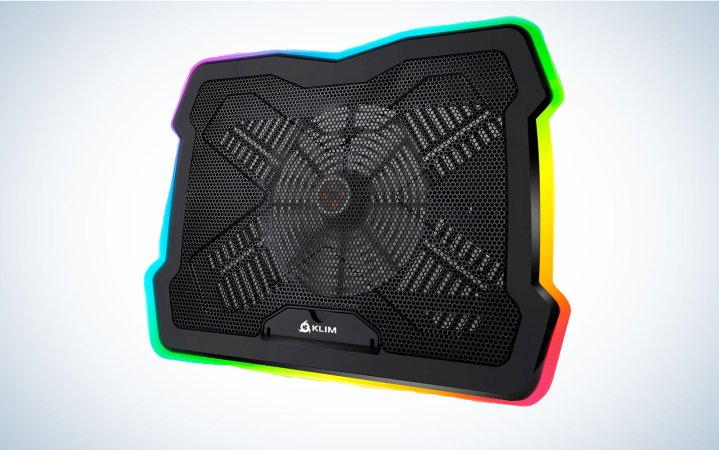We may earn revenue from the products available on this page and participate in affiliate programs. Learn more ›
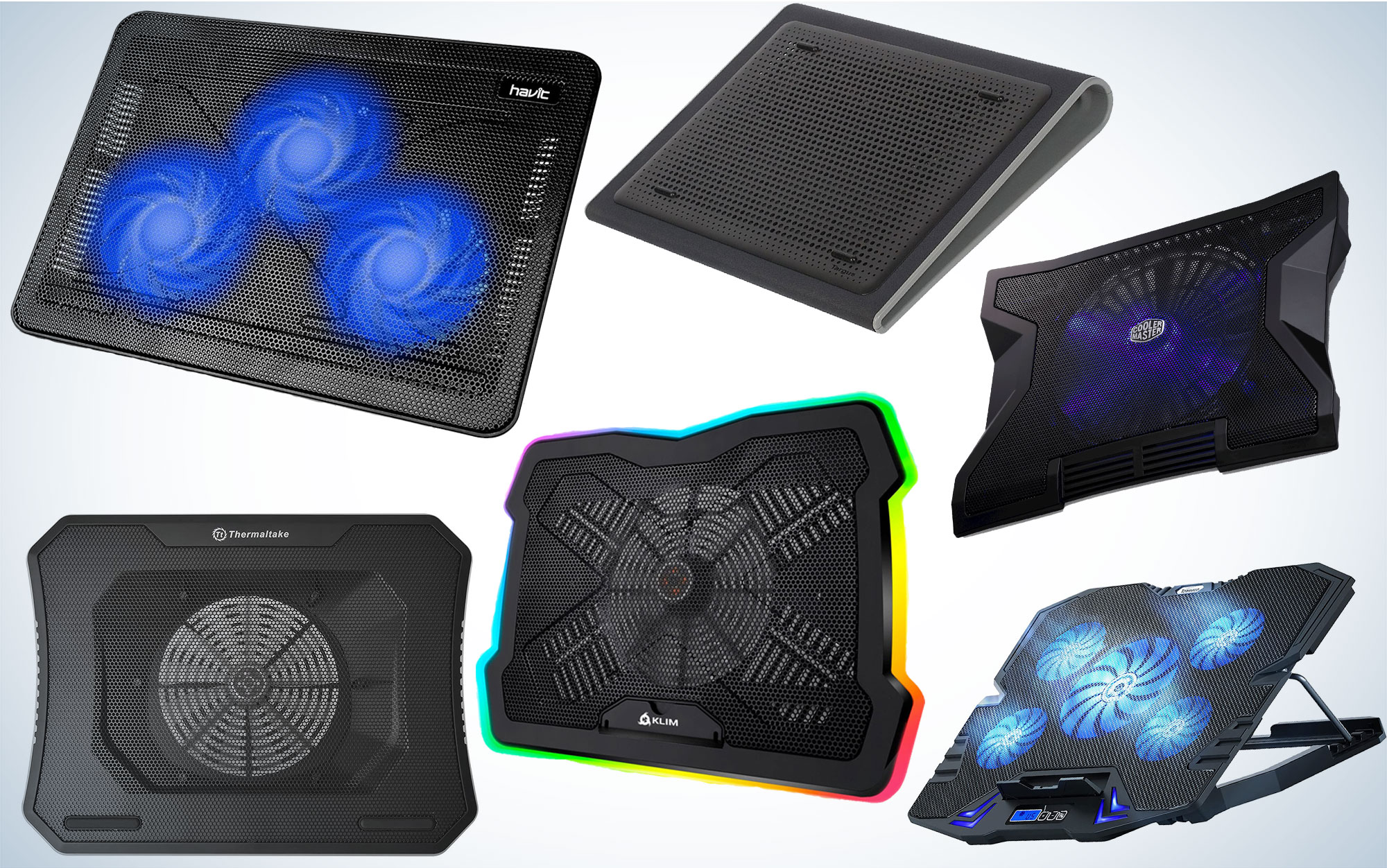
Using a laptop to play your favorite game on the go? Get ready for some uncomfortable heat that you’ll want to escape—and fast. Whether you just want to cool down your PC when it’s actually in your lap or enhance its internal ventilation, a cooling pad can be a useful, even necessary way to keep your laptop from overheating. As with every gadget, it can be difficult to figure out what kind works best for you and your machine. Luckily, we’ve selected some of the best laptop cooling pads available now, with options to fit most buyers’ use cases and budgets.
- Best for big computers: Thermaltake Massive 20 RGB
- Best quiet: Cooler Master Notepal XL
- Best thin: havit Laptop Cooler Cooling Pad
- Best for gaming: KLIM Ultimate Laptop Cooling Pad
- Best for your lap: Targus 16-inch Dual Fan Chill Mat
- Best budget: TopMate C5 Laptop Cooling Pad
How we chose the best laptop cooling pads
When selecting the best laptop cooling pads, I looked back on all the pads I’ve owned over the years. I have tried a wide variety of different pads with varying fan strengths and laptops that tend to heat up quickly. I have primarily used larger laptops throughout my career while reviewing games and creating similar PC-focused coverage, most of which have become uncomfortable to remain in my lap. This has occasionally made cooling pads a necessity, especially early on when I was just making a name for myself and couldn’t afford top-of-the-line tech or an office setup that allowed me proper ergonomics. In addition to my own experience, I’ve gathered recommendations from fellow tech reviewers, as well as customer reviews.
The best laptop cooling pads: Reviews & Recommendations
Laptop cooling pads, a plastic base stand for your laptop with large external fans, can enhance your PC’s performance. (Or, at the very least, keep them from blowing hot air on you.) There are a ton of laptop cooling pads out there. Our picks for the best pads offer a wide array of options geared toward specific types of users, from gamers with giant laptops to productivity-focused models designed to make an impact while staying out of your way. We also have options for people who want to spend as little as possible. Whatever your reason for investing in one of the best cooling pads, we’ve got your back.
Best for big computers: Thermaltake Massive 20 RGB
You’ll Be a Big Fan of This Big Fan
Pros
- Can fit pretty much any laptop ever made
- Adjustable height
- RGB lighting
Cons
- Very large
Specs
- Dimensions: 13 x 2.5 x 14.25 inches
- Number of Fans: 1 (200mm)
- Fan Speed: Up to 800 RPM
- Compatibility: Fits up to 19-inch laptops
For this laptop cooler, the name says it all. The Thermaltake Massive 20 RGB is the best laptop cooling pad for really big computers. Good external cooling for large gaming laptops can be hard to find on account of their unconventionally large chassis designs. This refreshed version of the Thermaltake Massive 20 is large enough to cool a monster “desktop replacement” laptop and features RGB lighting.
Unfortunately, its greatest strength is also its most significant issue. The Massive 20 RGB is very big. And while it can technically accommodate smaller laptops, it’s likely overkill for an ultrabook or a smaller laptop. The size also makes it a desk-only option.
Best quiet: Cooler Master Notepal XL
Thin, Quiet, and Frosty
Pros
- Built-in USB hub with three USB-A ports
- Thin, attractive design
Cons
- Fan LED is blue-only
Specs
- Dimensions: 12.01 x 14.92 x 1.85 inches
- Number of Fans: 1 (230mm)
- Fan Speed: Up to 800 RPM
- Compatibility: Fits up to 17-inch laptops
If the Thermaltake Massive 20 RGB is too massive, the Cooler Master Notepal XL, as the best quiet laptop cooling pad, is a smaller alternative that doesn’t compromise too much on overall cooling power. In addition to being thinner and lighter, the Notepal XL features a USB Hub, adding three additional USB-A ports if you plug it in via USB. Our only complaint? The fan’s LED light only glows one color. That may not seem like a significant issue, but if you’ve spent thousands on a laptop and accompanying setup, finding out that the lighting clashes with your setup can be quite annoying.
Best thin: havit Laptop Cooler
Picking Slim
Pros
- Metal mesh construction
- Thin and portable
- Three fans are better than one
Cons
- No fan speed control
Specs
- Dimensions: 14.96 x 1.18 x 11.02 inches
- Number of Fans: 3 (110mm)
- Fan Speed: Up to 1,100 RPM
- Compatibility: Fits up to 17-inch laptops
The havit laptop cooler cooling pad is one of the best thin laptop cooling pads. Even with a slimmer form factor, it doesn’t sacrifice cooling power, though. Its three fans can spin up to 1,100 RPM, chilling even very hot gaming laptops. Unfortunately, it lacks a fan control, so you can’t dial back the power or, more importantly, turn down the sound of the fan spinning at full blast.
Best for gaming: KLIM Ultimate Laptop Cooling Pad
Color Me Cool
Pros
- Four height settings
- RGB colors pop
Cons
- Can be hard to reach rear controls at certain height settings
Specs
- Dimensions: 16.73 x 12.4 x 1.69 inches
- Number of Fans: 1 (200mm)
- Fan Speed: Up to 750 RPM
- Compatibility: Fits up to 17-inch laptops
As the best laptop cooling pad for gaming, the KLIM Ultimate Laptop Cooling Pad is the RGB lover’s external cooling solution. It has a large, lower RPM fan that makes for quiet cooling. The lighting elements surround the pad, maximizing its colorful display, which you can customize with one of five strobing effects and seven color combinations. It also has four different height settings, which is great in theory but can make it hard to reach the rear lighting and fan controls, according to some users.
Best for your lap: Targus 16-inch Dual Fan Chill Mat
Keep Your Laptop on Your Lap
Pros
- Rubber stops keep it from slipping
- Tilts slightly forward to help weight distribution
Cons
- No USB hub
Specs
- Dimensions: 14.1 x 1 x 10.6 inches
- Number of Fans: 2 (80mm)
- Fan Speed: 1,900 RPM
- Compatibility: Fits up to 17-inch laptops
Most laptop coolers are designed to sit on a desk as part of a semi-permanent laptop workstation. That’s fine for some, but now that so many of us work from home, our “office” shifts daily. The Targus Dual Fan Chill Mat is one of the best laptop cooling pads for your lap that is actually meant to keep your laptop cool enough to rest. Its rounded edges and rubber pads keep it from slipping and it has a slight tilt to help with typing. If there’s one real drawback here, it’s the lack of a USB hub or USB passthrough.
Best budget: TopMate C5 Laptop Cooling Pad
More Fans, Less Cash
Pros
- Affordable
- LCD screen tells you what mode you’re on
- Two additional USB ports
Cons
- No way to turn off LEDs
Specs
- Dimensions: 13 x 2.5 x 14.25 inches
- Number of Fans: 5 (120mm x 1, 65mm x 4)
- Fan Speed: Center fan: 1,200 RPM, Outer fans: 2,400 RPM
- Compatibility: Fits up to 15.6-inch laptops
The TopMate C5 Laptop Cooling Pad is the best cheap laptop cooling pad, but it’s surprisingly feature-packed. It combines four small fans with one larger center fan to provide maximum cooling power. It’s also the only cooler on the list with an LCD display that provides information on the current settings. Unfortunately, the blue LEDs can’t be disabled, and they’re relatively bright, which might be annoying for some users. There are also two additional USB ports at the rear of the cooling pad, which let you power additional devices.
What to consider when buying the best laptop cooling pads
There are a ton of different cooling pads out there. They come in many different shapes and sizes. Do you want a thinner, quieter cooling pad that no one will ever notice? Or do you prefer something bold and colorful? The cooling power, compatibility with different laptop sizes, and connection options all make a difference, so pay attention to these things when you consider making a purchase.
What size pad should you buy?
When choosing a cooling pad, you’ll want to find one that fits the size of your computer. If it can’t fit under your device, you won’t get adequate cooling out of your new equipment. The cooling pad’s size may also have an impact on your home laptop setup: Keep in mind that a thicker, more powerful cooler will also lift your laptop higher off your desk (or lap) than a thin, stealthy one.
How powerful are the fans?
When you really think about it, a laptop cooling pad is really just an extra set of external fans. Comparing any set of cooling pads largely comes down to comparing the size and power of the fans.
Fan speed is crucially important. The faster the fans spin, the more air will blow to keep your laptop cool. Look for products with a higher number in this category, which signifies a stronger fan. An average laptop cooling pad’s speed range should be anywhere from 1,000 to 1,500 RPM. Anything higher will be incredibly efficient and able to chill your laptop much quicker.
You’ll also want to look at the size of the fan (or fans) in the cooling pad. An average fan size of around 90-120mm for each unit is a good place to start. Some larger pads opt for an XXL fan, as large as 800mm. Bigger fans theoretically should be more powerful, as they can push more air than a smaller fan spinning at the same speed. A bigger fan moving at a slower speed may ultimately be less effective than a set of smaller fans blowing at high speed on the right spots. Ultimately, you need to look at both fan size and speed to get a full understanding of how much cooling the pad provides.
Being able to adjust a cooling pad’s fans is a perk, as you may not want them running at full blast all the time. In the end, choosing more powerful fans (in terms of either RPM or fan size) means you won’t have to wait as long to lower your laptop’s temperature, even if it has issues overheating regularly.
Can you put it on your lap?
Consider where you use your laptop before buying a cooling pad. Some cooling pads are a bit more unwieldy than others. Some are solidly built, like tanks, and meant to sit on a desk or table as part of a PC setup. Others are specifically made to slide under your laptop when resting on your legs. Ultimately, you will need to choose between higher power and a more versatile, portable pad, so keep in mind whether you’re buying it to keep your laptop from melting or to stay comfortable.
FAQs
No, you don’t always need a cooling pad for your laptop. Laptops are already designed with cooling measures to avoid overheating to the point where they break themselves. That said, some gaming and content creation laptops can achieve small performance gains with better cooling, especially when your laptop is pushed to its limits. An older and/or cheaper laptop can get so hot it starts to perform worse or even needs to shut down: If you find yourself in that situation, a cooler can slow down the effects of overheating. The most profound effect, however, may be that a hot laptop can be uncomfortable to use, especially if you put it on your lap.
The only way a laptop cooling pad could negatively affect your laptop is if it blows hot air back into the chassis. If your laptop exhausts hot air down and your cooler blows air up, it would just be blowing the hot air back into the laptop. As a precaution, consider checking your laptop’s fans and find where the hot air blows out of your machine so you can avoid this problem.
The degree to which a cooling pad chills a laptop depends on many variables, even with a specific laptop. Cooling performance will depend on the model of cooling pad, the model of laptop, how hard you’re pushing the laptop, ambient temperature, and humidity, among other factors.
As long as the cooling pad isn’t fighting against a laptop’s exhaust, there should be some improvement. However, these products are far from a silver bullet. A CPU cooler will allow you to run a game at higher settings or otherwise do things that your laptop couldn’t do before. If your laptop is overheating regularly to the point where it malfunctions or shuts down, there’s probably an issue with your system that will need to be repaired.
Final thoughts on the best laptop cooling pads
- Best for big computers: Thermaltake Massive 20 RGB
- Best quiet: Cooler Master Notepal XL
- Best thin: havit Laptop Cooler Cooling Pad
- Best for gaming: KLIM Ultimate Laptop Cooling Pad
- Best for your lap: Targus 16-inch Dual Fan Chill Mat
- Best budget: TopMate C5 Laptop Cooling Pad
Choosing the best laptop cooling pad is a great idea if you spend a lot of time working or gaming on a particular type of computer. Whether your lap gets a little sweaty when you’re getting some work done or you want your gaming laptop to chill out when playing your favorite game, try out a cooling pad for good results. There are plenty to test out, and most are affordable enough that it’s easy to see which one works best for you.
